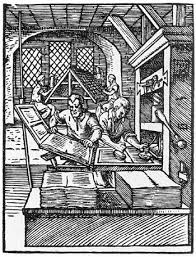As early as the year 1040, the Chinese had made movable type out of clay and earthenware. The innovation, for a variety of reasons, did not catch on in the East, but four centuries later it became the center of a revolution in Europe. In 1439, the craftsman Johannes Gutenberg used movable type in his shop in Mainz. His screwpress method was so effective that for three and a half centuries little was done to improve its design. But evolve it did, becoming ever more complex and efficient, bringing the written word to ever greater swaths of the population.
 The movable type printing press has seen an enormous evolution from its starting point, the majority of which happened after 1800 with the opportunities and incentives provided by the industrial revolution. From clay characters in China, to Gutenberg, to ever-running newspaper operations, the evolution of printing technologies prove that words are a narcotic, and engineers and inventors have been happy to meet the demand. Below are videos illustrating the development of the printing press through the centuries.
The movable type printing press has seen an enormous evolution from its starting point, the majority of which happened after 1800 with the opportunities and incentives provided by the industrial revolution. From clay characters in China, to Gutenberg, to ever-running newspaper operations, the evolution of printing technologies prove that words are a narcotic, and engineers and inventors have been happy to meet the demand. Below are videos illustrating the development of the printing press through the centuries.
1). The Gutenberg Press
No one could have anticipated that Johannes Gutenberg, whose previous venture was to manufacture mirrors to sell to pilgrims in Mainz as souvenirs, would have invented a machine to revolutionize history and culture forever. This museum demonstration describes a few of the panoply of practical triumphs involved in the press, including the ink ball, the tympan-and-frisket fastening system, and the repurposed wine-screw design to drive the ink home. What is perhaps most striking about the video is to see the many different aspects that required talent and skill to perfect, in everything from ink-setting to bringing the platen down.
2) Steel Replaces Wood
Here, an Irish historian prints a Seamus Heaney poem with an Albion press, one of the popular iron presses to follow the creation of the Stanhope press, which liberated the technology from wooden construction in the year 1800. Though the machine is more compact and manageable than the Gutenberg variety, it demonstrates that from 1439 to 1800 very little changed in terms of the construction of the printing press. The machine still entails the same principles of inking the type (the man uses a brayer rather than an ink ball this time), and exhibits the same basic screw-press format to impress the inked plate onto the paper. Many of these machines are coveted today for use in hobbyist and letterpress printings.
3) Mergenthaler's Linotype Machine
In the late 19th century, the “second Gutenberg” Ottmar Mergenthaler invented the linotype machine, which vastly sped up the printing process by bypassing the need to pick type by hand from a case. Beginning with an enthusiastic intro, this video shows a still-kicking linotype machine at a letterpress business in Brooklyn, showing the very craft innovation Mergenthaler’s machine introduced (other fine press houses, like Nawakum Press, still use similar machines to set their books). While some competitors attempted to create a machine that absorbed and resorted type, the linotype machine holds a basin of molten lead to cast new type itself, allowing the printer to operate a keyboard and slugs of type much faster than if she was working with case and tweezer. It’s a marvel how much complexity went into the machine.
4) Modern Factory Operations
Among the significant alterations to the Western printing press to follow Gutenberg was the replacement of the flat plate for a cylinder. This method was pioneered by inventors like Richard March Hoe, whose massive 1871 rotary press offered bulk and efficiency to meet the demands for the burgeoning market for periodicals in the 19th century.
Like automobiles, printing presses have become more efficient and complex, all while becoming less fun and educational to look at. Even a newspaper printing setup from 80 years ago would look like a bewildering mass of reams and rollers and intricate iron parts. This contemporary video from the Daily Astorian describes how yellow, cyan, and magenta are “registered” to make nearly any color for their daily print run of about 8,000 copies.









